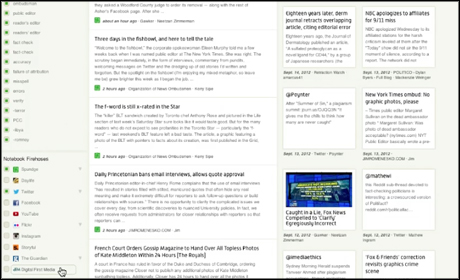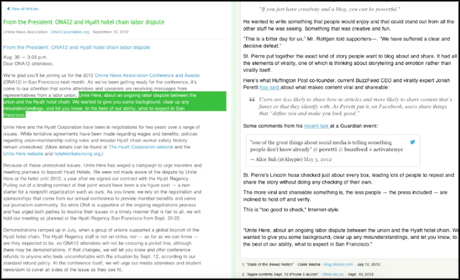The platform aims to help journalists "gather, curate and publish a lot faster", journalist in residence at Spundge Craig Silverman told Journalism.co.uk.
In a blog post explaining the thinking behind the platform, Silverman explains the concept is to offer a "terminal for journalists".
"It’s a Bloomberg terminal for journalists. It’s an end to workflow madness and the start of something more efficient, more collaborative, and built for what journalists actually do."
It offers a range of services, from bookmarking, content collection and curation, web searching and filtering, to publishing and syndication, which together are designed to "help journalists and entire newsrooms do a much more efficient job of staying on top of the topics and people and companies and other items they need to track".
The platform also enables collaboration on content collection, annotation and curation, with built in elements to ensure accurate attribution when referring to content from across the web.It’s a Bloomberg terminal for journalists. It’s an end to workflow madness and the start of something more efficient, more collaborative, and built for what journalists actually doCraig Silverman
The filtering and collection of content in what it calls 'notebooks' is a free service, while the ability to write stories in the platform and syndicate them to digital platforms is part of a pro service which costs $9 a month per person.
"For a lot of journalists we have a few different ways of gathering information for stories, one might be interviewing people, working sources we have, but a lot of the times we're actually seeing what other people have reported or what's on social media and really bringing that together to synthesise something new," Silverman said.
"Spundge is really great for doing that last part there, of finding stuff from other news sources, from social, pulling it together and then enabling you to really quickly turn that into content."
Here is more information on the specific ways journalists can use the platform, as outlined by Silverman:
- Adding content to a 'notebook'
Content can also be added within the Spundge interface, and notebooks can be directly accessed via the browser extension, for example.Rather than having to look on Twitter and then also having to look maybe at Facebook and then maybe also having to look in your RSS feeds, you can do it all in one placeCraig Silverman
"A notebook is the place where you can really stay on top of beats, on top of a person, a place, a thing, any kind of topic you need to be watching," Silverman explains.
Notebooks house streams of content based on filters such as keyword searches and information source selections, and also provide a place to store certain saved results.
"Rather than having to look on Twitter and then also having to look maybe at Facebook and then maybe also having to look in your RSS feeds, you can do it all in one place," Silverman adds.
Within Spundge, users can add keywords as filters for notebooks, to tell the system "these are all the words that indicate something might be related to the topic of this notebook".

These keywords are then applied across different information sources – or "fire hoses" – as Spundge calls them. These include Facebook, YouTube, Flickr, Instagram and Twitter.
There is also a Spundge fire hose which includes more than 25,000 RSS feeds "from news sites and influential blogs from around the world".
The platform has also looked at integrating other sources such as social news wire Storyful, which would mean the wire's customers who use Spundge could search its content within the platform.
Similarly, as part of its testing, Spundge was able to use the Guardian's open API to build its content into a 'fire hose', as well as Digital First Media in the US.
"So we actually took all of the RSS feeds from all of their properties, turned them into a fire hose so they can very easily see what's already been reported."
There are also further ways to filter results, such as by creating notebooks tracking keywords within specific, imported RSS feeds or "selected Twitter lists".
Results can also be returned by "social engagement filters", such as only showing tweets from accounts with a certain number of followers, or based on the number of retweets a tweet gets. Users can also filter by date, location and language.
The system also learns over time which results are most relevant based on how content is being marked by the user.
"There's machine learning that happens and the stream just gets more and more relevant."
Silverman said "one big thing about Spundge is it is collaborative as well", with newsrooms able to have multiple team members working on notebooks, for example.
"So the layer of discovery and curation actually has another layer on top which is collaboration.
"So you can work with people to actually curate a notebook, stay on top of an item, maybe someone comes on shift and they need to know what's already happening, they can open up a notebook and see what their colleagues have been saving and annotating."
- Embedding streams
The system will therefore take the saved items within a notebook and, based on the number you request, provide an embed code to then enable the publishing of the notebook's stream of collected content elsewhere.
"So again if it's a breaking news event and you want to be showing the latest stuff that your team is finding, you can do that just by throwing an embed code up somewhere.
"It's also a great way internally to share the things that people are working on and to see who's saving what."
- Creating new content
"This gets rid of the problem where journalists have like 20 browser tabs open when they're trying to work on a story or a blog post," Silverman says.

Given Silverman's background as editor of the Regret the Error blog, another important element is automatic attribution which occurs when content is copied from saved content into a new story. He says this will act as a flag to journalists to help them remember the sources of the referenced material, which can also be made public as footnotes.
Once a story has been created it can then be published direct to a WordPress site, or sent as a draft. At the same time an update can be sent to Twitter and Facebook accounts.Instead of writing in one place, keeping your research in another, and then doing your social promotion in a third you can do all of that in one placeCraig Silverman
Pro account users can also add a Google Analytics tracking code to articles to monitor where they have been embedded.
As Silverman sums up: "Instead of writing in one place, keeping your research in another, and then doing your social promotion in a third you can do all of that in one place."
The free version of Spundge is now available via sign-in, while those interested in a pro account need to contact @Spundge directly.
- Digital publishing director within Trinity Mirror's regional division David Higgerson blogged about Spundge on Friday, and outlined 10 ways journalists can use it
Free daily newsletter
If you like our news and feature articles, you can sign up to receive our free daily (Mon-Fri) email newsletter (mobile friendly).
Related articles
- WAN-IFRA launches gaming tool NewsArcade with six-month free trial
- Brian Whelan from Times Radio on growing a successful YouTube news channel
- Nine AI hacks for newsroom leaders to promote employee wellbeing
- How journalists can decode 'algospeak' on social media
- Rachel Duffy, senior social media editor of The Telegraph, on using Reddit for news









